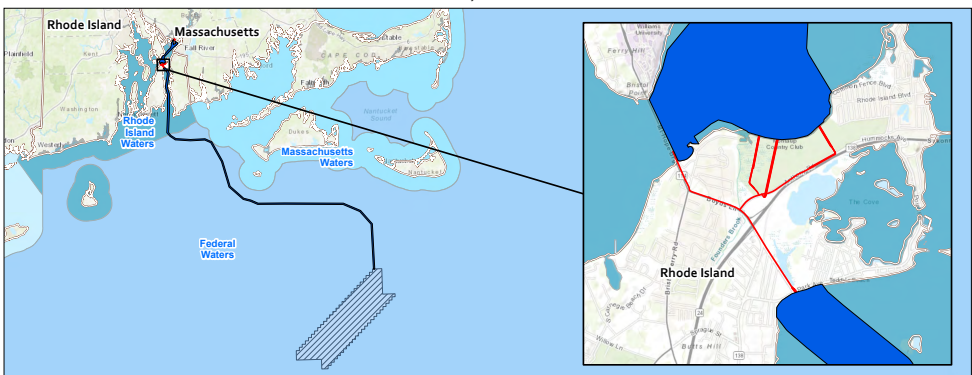A map rendering showing the proposed path of power lines from SouthCoast Wind up the Sakonnet River to connect in Somerset. (Courtesy Southcoast Wind Energy LLC)
A proposal to run underwater power lines from a Massachusetts offshore wind farm through Rhode Island waters is back before state regulators, following a 14-month pause.
The Rhode Island Energy Facility Siting Board voted unanimously Monday to resume consideration of SouthCoast Wind Energy LLC’s application to run transmission lines from its wind farm 30 miles south of Martha’s Vineyard up the Sakonnet River, over Portsmouth and out Mount Hope Bay to reach land in Somerset.
The 149-turbine array proposed for federal waters 60 miles south of the Rhode Island coastline is governed largely by the U.S. Bureau of Ocean Energy Management. But Rhode Island agencies also have a say over the portion of underwater transmission lines in state waters.
The initial, 1,200 megawatt SouthCoast Wind Farm would have supplied all of its power to Massachusetts under agreements inked in 2019. But in June 2023, the developer walked away from those agreements, citing rising project costs and the need for a more favorable deal. In turn, the Rhode Island Energy Facility Siting Board opted to halt its review of the transmission line component.
The board’s July 2023 decision to set aside the application required the Spanish developer to submit new documents proving it had new, tentative agreements in place for its project. Which is exactly what was turned in on Sept. 11, following results of a regional competitive solicitation in which SouthCoast won bids in Rhode Island and Massachusetts.
The project itself remains largely the same: up to 147 turbines providing up to 1,287 megawatts of wind-generated electricity. The bulk of the power — 1,087 megawatts — would be funneled to Massachusetts, while Rhode Island has agreed to buy the remaining 200 megawatts, under tentative agreements announced by both states on Sept. 6. The project again relies on 2-mile-long, high-voltage cables to transfer the wind energy along Aquidneck Island before making landfall at Massachusetts’ Brayton Point.
New project pricing has not been made public, but is expected to be revealed when, and if, contracts are finalized and details submitted to the Rhode Island Public Utilities Commission, likely at the end of the year.
In the meantime, various state and local agencies have four months to submit advisory opinions to the Energy Facility Siting Board regarding the transmission line component. The prior proposal drew criticism from area fishermen over potential disruption to key fishing grounds. The towns of Portsmouth, Middletown and Little Compton also cited potential concerns over the safety, noise and traffic created during construction, though Portsmouth’s Town Council in January signed an agreement giving the developer access to its land in exchange for $23 million over the next 33 years.
A separate regulatory body, the Rhode Island Coastal Resources Management Council, also approved the transmission line component of the project, imposing a set of conditions aimed at minimizing environmental harm and impacts to fishermen as part of its December 2023 decision. A separate permit application with the same agency remains under review by the CRMC.
Advisory agencies typically have six months to make their recommendations to the Energy Facility Siting Board. The four-month deadline approved by the board was based on the developer’s request for a speedier review.
Ronald Gerwatowski, chairman of the Energy Facility Siting Board, acknowledged the need to pick up the pace after a more than yearlong delay.
“I think it’s sending the signal that this project is important,” he said.
Jennifer Flood, head of permitting for Ocean Winds North America, the Spanish company behind the project, said in a statement Monday afternoon that the developer looks forward to resuming the review process.
“The SouthCoast Wind project is vital to Rhode Island’s and Massachusetts’ goals of increasing grid reliability, reducing greenhouse gas emissions, prioritizing the development of clean energy resources, and creating economic growth,” Flood said.
The company expects to begin construction on its project in late 2025, pending federal, state and local permits, with a 2030 completion date.
GET THE MORNING HEADLINES DELIVERED TO YOUR INBOX

